
Chitons are marine molluscs of varying size in the class Polyplacophora, formerly known as Amphineura. About 940 extant and 430 fossil species are recognized.

Monoplacophora, meaning "bearing one plate", is a polyphyletic superclass of molluscs with a cap-like shell now living at the bottom of the deep sea. Extant representatives were not recognized as such until 1952; previously they were known only from the fossil record, and were previously thought to have become extinct over 380 million years ago.
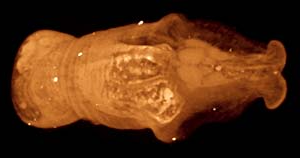
Aplacophora is a presumably paraphyletic taxon. This is a class of small, deep-water, exclusively benthic, marine molluscs found in all oceans of the world.
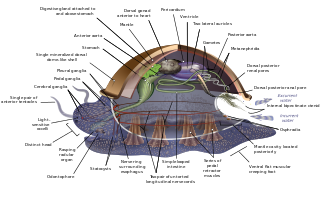
The evolution of the molluscs is the way in which the Mollusca, one of the largest groups of invertebrate animals, evolved. This phylum includes gastropods, bivalves, scaphopods, cephalopods, and several other groups. The fossil record of mollusks is relatively complete, and they are well represented in most fossil-bearing marine strata. Very early organisms which have dubiously been compared to molluscs include Kimberella and Odontogriphus.

Neopilina is a highly derived genus of modern monoplacophoran.
Lepidopleurus is an extant genus of chitons in the family Leptochitonidae.
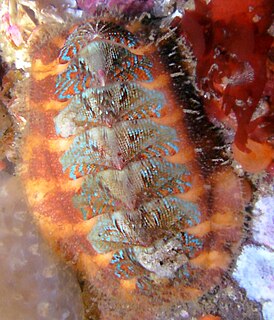
Mopalia spectabilis, commonly known as the red-flecked mopalia, is a species of chiton.

Chiton magnificus, the liquorice sea cradle, is a Southeast Pacific species of edible chiton, a marine polyplacophoran mollusk in the family Chitonidae, the typical chitons.

Mollusca is the second-largest phylum of invertebrate animals after the Arthropoda. The members are known as molluscs or mollusks. Around 85,000 extant species of molluscs are recognized. The number of fossil species is estimated between 60,000 and 100,000 additional species. The proportion of undescribed species is very high. Many taxa remain poorly studied.

Acanthopleura granulata, common name the West Indian fuzzy chiton, is a medium-sized tropical species of chiton. This type of chiton’s activity does not depend on spring-neap oscillations leading to lower locomotion loss. Its morphology is different from usual chitons as it has a fifth valve, which is split into halves.
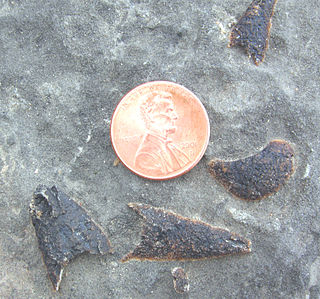
Matthevia is a genus of Cambrian molluscs, perhaps related to the chitons. It consists of repeated monoplacophoran-like shells; according to one hypothesis, chitons arose when these tall shells began to overlap over the generations. The tall element of the shell was retained and forms the tips of modern chiton plates. There are distinct head, 'centre', and tail valves, which occur approximately in the ratio 1:5:1 — suggesting a seven-plated configuration.
Robustum nodum is the one species of a problematic genus of Ordovician hemithecellid mollusc proposed by Stinchcomb and Darrough in 1995. Its similarities to Matthevia were outlined by Vendrasco & Runnegar.
Echinochiton is an extinct genus of Ordovician chitons with hollow spines on its margins; these spines, which are unique among the chitons, have a strong organic component and show growth lines.

Hanleya is a genus of polyplacophoran molluscs known from Oligocene and Miocene fossils; it is represented today by a number of species including H. sinica Xu 1990 (China), H. brachyplax (Brazil) and H. hanleyi Bean in Thorpe, 1844 (Chile), which feeds on sponges.
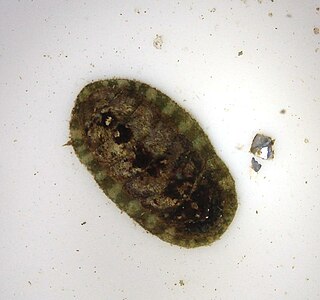
Lepidochitona is a genus of chitons. It has been included in the families Tonicellidae, Ischnochitonidae, and Lepidochitonidae.
Polysacos is an extinct genus of multiplacophorans (chitons) known from articulated Carboniferous fossils; its seventeen shell plates are arranged in three rows, with seven iterated units. It demonstrates that multiplacophora are related to modern polyplacophora. It was fringed with a ring of hollow spines resembling those of the Ordovician Echinochiton.
Multiplacophora is a stem-group of chitons with a number of plates arranged in 7 rows along the body. They date to at least the Upper Cambrian, but two lower Cambrian fossils- Ocruranus and Trachyplax - may extend the range downwards.
The Heloplacidae are a group of plated aplacophora known from Silurian deposits. Their best understood representative, Acaenoplax, can be taken as representative of the family; it is the only genus for which soft part anatomy is known.
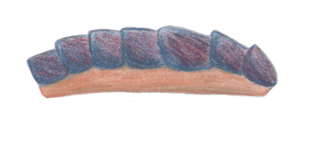
Kulindroplax perissokomos is a Silurian mollusk, known from a single fossil from the Wenlock Series Lagerstätte fauna of England. It lived during the Homerian Age. It is considered a basal aplacophoran. Unlike all modern aplacophorans, which are shell-less, Kulindroplax has a chiton-like shell, and it is considered a transitional fossil in the evolution of molluscs.
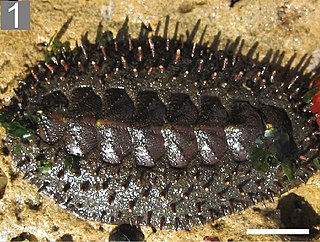
Acanthopleura echinata is a Southeast Pacific species of edible chiton, a marine polyplacophoran mollusc in the family Chitonidae, the typical chitons.











